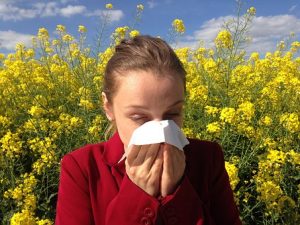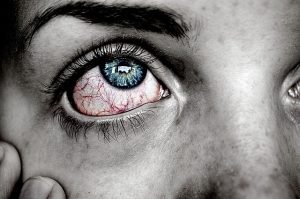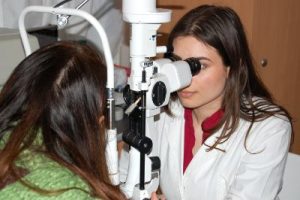Eye allergies are inflammatory conditions affecting the visual apparatus, mainly the conjunctiva.
The prevalence of allergic diseases is definitely on the rise, so much so that it is thought to have increased at least fivefold over the past 50 years. In fact, it is estimated that the percentage of people suffering from allergies is 15-20% of the world population. Ocular symptomatology in allergic subjects is present in 40-60% of patients according to the studies. That is to say, approximately 10% of the general population has or has suffered from allergic conjunctivitis.
 Allergic diseases are caused by allergens, substances that are harmless to most people but can trigger an excessive and uncontrolled immune response in some predisposed individuals. In fact, the particular sensitivity to these substances, determined by a genetic predisposition of the individual, causes allergic manifestations (or reactions) which can affect different parts of the body, causing various ailments and which, if neglected, can have a negative impact on quality of life and serious consequences on thevisual organ. It has also been shown that, contrary to popular belief, allergic disorders are not only present at particular times of the year, such as the spring season, but can occur in recurrent, perennial or chronic mannerthroughout the year, all over the country.
Allergic diseases are caused by allergens, substances that are harmless to most people but can trigger an excessive and uncontrolled immune response in some predisposed individuals. In fact, the particular sensitivity to these substances, determined by a genetic predisposition of the individual, causes allergic manifestations (or reactions) which can affect different parts of the body, causing various ailments and which, if neglected, can have a negative impact on quality of life and serious consequences on thevisual organ. It has also been shown that, contrary to popular belief, allergic disorders are not only present at particular times of the year, such as the spring season, but can occur in recurrent, perennial or chronic mannerthroughout the year, all over the country.
Allergy forms and symptoms
Ocular allergies, inflammatory conditions affecting the visual apparatus, mainly affect the conjunctiva, the transparent mucous membrane that lines the inside of the eyelids for the purpose of protecting the eyeball (see illustration).
Seasonal and perennial allergic conjunctivitis
Allergic conjunctivitis is, therefore, the most common form and is considered the ocular manifestation of allergic syndrome. It affects young people and adults of all ages, with a higher prevalence among between 20 and 40 years of age. ocular allergies are reactions of the immune system caused by foreign substances (antigens) with which the eye has previously come into contact and to which it has therefore already become 'sensitised'. When the eyes are exposed to allergens, antibodies are produced. If the allergens come into contact with the antibodies on the conjunctiva again, an allergic reaction takes place, whereby inflammatory chemicals are released from the cells (including histamine) that cause the symptoms of allergic conjunctivitis.
Very often, allergic conjunctivitis (especially seasonal conjunctivitis) is accompanied by the rhinitisthus causing extensive disorders of the mucous membrane of the nasal cavities. The particularity of this allergic condition requires the attention not only of the ophthalmologist but also of figures such as the allergist, general practitioner, paediatrician and pharmacist. The most common forms are seasonal allergic conjunctivitis (SAC) and perennial allergic conjunctivitis (PAC). The former manifests itself during that time of year when allergenic pollens, e.g. from grasses, are present in the environment, causing an allergic reaction not only in the ocular system, but also in the nasal passages causing what is called rhino-conjunctivitis. Perennial allergic conjunctivitis, on the other hand, concerns an antibody reaction to allergens that are not particularly seasonal, such as the dust mites, animal hair or moulds. In fact, CAP can occur at all times of the year regardless of the seasons.
Symptoms of allergic conjunctivitis
The typical symptomatology of allergic conjunctivitis (both seasonal and perennial) is characterised by the appearance of:

- ocular hyperemia (redness)
- lacrimation
- itching
- slight eyelid oedema (swelling)
- burning
While in seasonal allergic conjunctivitis these symptoms may present themselves as a form occasional short-lived, as far as perennial conjunctivitis is concerned, the symptomatology is chronic or persistentDiagnosis of the different forms of ocular allergies always begins with a comprehensive anamnesis and a careful evaluation of the patient's ocular symptoms and visible signs.
Treatment
The pharmacistfirst of all, it must advise the patient to identify and remove the agents causing the allergic manifestation as soon as possible, it may also recommend the use of tear substitutes. In particular, in order to lubricate and moisturise the ocular surface and to help restore comfort, the use of ophthalmic solutions based on hyaluronic acid.
-
Hyaluronic Acid
Hyaluronic acid is a molecule that has been used for many years as an ocular lubricant due to its special characteristics. It has a structure that gives it a special ability to combine with water and excellent viscoelasticity. The property of hyaluronic acid to bind large amounts of water and that of mimicking the behaviour of mucins help to maintain the stability of the tear film and ensure optimal ocular protection and lubrication. In addition to these special properties, hyaluronic acid also plays an important biological role in corneal repair processes by promoting cell motility, adhesion and proliferation.
 In the presence of allergic manifestations, it is possible to suggest tears containing soothing and decongestant substances such as extracts of camomile, linden and eyebright, indicated to provide relief in cases of eye irritation, burning sensation and in general in cases of discomfort ocular generated by various environmental factors (such as smog, dust, wind, etc.).
In the presence of allergic manifestations, it is possible to suggest tears containing soothing and decongestant substances such as extracts of camomile, linden and eyebright, indicated to provide relief in cases of eye irritation, burning sensation and in general in cases of discomfort ocular generated by various environmental factors (such as smog, dust, wind, etc.).
The diagnosis of allergic forms must be made by the specialistwho will prescribe ophthalmic solutions to treat ocular allergic manifestations antihistamines and membrane stabilisers.
In the most serious the ophthalmologist may also have to resort to prescribing a pharmacological treatment involving the administration of steroidal and non-steroidal anti-inflammatory drugs.
Prevention
With regard to allergic conjunctivitis, especially those associated with the seasonalityprevention is possible by taking a few small steps:
 - Instill regularly lubricants or artificial tears to prevent the ocular surface from coming into contact with allergens
- Instill regularly lubricants or artificial tears to prevent the ocular surface from coming into contact with allergens
- Use sunglasses to protect the eyes
- Reduce as much as possible exposure to pollen avoiding windy areas
- Change sheets, blankets and pillows frequently and vacuum as much as possible to avoid the accumulation of allergens
- Frequent washing hands and avoid rubbing your eyes
Rare ocular allergic forms
Less common ocular allergic forms trigger (unlike SAC and PAC) a hypersensitivity both immediate and delayed, the latter being responsible for the chronicity of the inflammatory condition.
- Spring Kerato-conjunctivitis (Vernal Kerato-Conjunctivitis - VKC) is considered a rare disease, characterised by an as yet unclear and defined aetiology. VKC affects both eyes and may result in a when clinical quite serious and, if not treated properly, risks having permanent consequences on the affected person. It is characterised by a chronic inflammatory condition, with a flare-up period during the spring season, involving both the cornea and conjunctiva. In males, VKC affects more frequently during adolescencewhile in females it appears more commonly in adulthood as, if it arises during the first ten years of life, it tends to disappear spontaneously (although not in all cases). I symptoms Associated with this severe form of allergy are, in addition to the common ones, photophobia (discomfort caused by light), foreign body sensation, blurred vision, intense mucus production and the presence of conjunctival mucous membrane eversions. The particularity of this pathology forces the specialist to treat patients with eye drops based on cortisone for a long time - with the side effects that this entails.
 Atopic Kerato-conjunctivitis (Atopic Kerato-Conjunctivitis - AKC) is a rare form of chronic ocular allergy affecting the cornea and conjunctiva that affects patients with atopic dermatitis. In severe cases it can lead to retinal detachment and cause blindness. This form of allergy, which can start during adolescence and continue into adulthood, is many times associated with other conditions such as blepharoconjunctivitis or viral herpes simplex infections. The symptoms, although overlapping with those of other allergic conjunctivitis, are characterised by a greater severity. AKC, in its more severe forms, must be treated with corticosteroids orally, cyclosporine or triamcinolone acetonide.
Atopic Kerato-conjunctivitis (Atopic Kerato-Conjunctivitis - AKC) is a rare form of chronic ocular allergy affecting the cornea and conjunctiva that affects patients with atopic dermatitis. In severe cases it can lead to retinal detachment and cause blindness. This form of allergy, which can start during adolescence and continue into adulthood, is many times associated with other conditions such as blepharoconjunctivitis or viral herpes simplex infections. The symptoms, although overlapping with those of other allergic conjunctivitis, are characterised by a greater severity. AKC, in its more severe forms, must be treated with corticosteroids orally, cyclosporine or triamcinolone acetonide.- Allergic contact dermato-conjunctivitis is an allergic form that affects both eyes and skin. It arises following contact of the skin or eyelids with certain substances or products, such as: contact lenses and detergents for cleaning them, cosmetics or accessories (e.g. brushes) for make-up. For this reason, it occurs more in women and the symptomatology is similar to other forms of allergy. In milder forms, dermo-ocular health can be restored simply by eliminating the contact with agents that cause the allergy while, in more severe forms or when there is difficulty in identifying the allergen that causes this condition, it may be necessary to use medicines cortisone.
- Giant Papillary Conjunctivitis (GPC)Finally, it is an inflammatory condition that causes swelling and irritation of the inner eyelid. It is associated with the frequent use of contact lenses soft, semi-rigid or rigid or arises as a result of mechanical trauma combined with a hypersensitivity reaction. Moreover, this pathology does not necessarily manifest itself at first contact with the lens, but also after several years of use. Often, to treat this allergic form, it is necessary to do not wear lenses for the time needed for the eye to heal and then change the type of lens, combining this with the use of eye drops prescribed by the ophthalmologist. If not treated properly, it risks causing damage both the eyelid and the cornea.
This article can also be downloaded in pdf format. To download click here: Sheet 3 - Ocular Allergies
© Copyright "l'Oculista italiano" - June 2019
Dr. Carmelo Chines
Direttore responsabile
